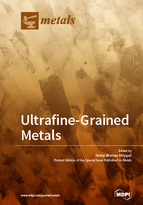Ultrafine-grained Metals
A special issue of Metals (ISSN 2075-4701).
Deadline for manuscript submissions: closed (31 March 2015) | Viewed by 107487
Special Issue Editor
Interests: fatigue mechanisms of metallic materials; mechanical properties and their correlation to microstructure; in-situ deformation; nano-crystalline /ultrafine grained materials; light metals
Special Issues, Collections and Topics in MDPI journals
Special Issue Information
Dear Colleagues,
Ultrafine-grained metallic materials produced by severe plastic deformation methods have become rather prominent during the last decade. These materials are at the cutting edge of modern materials science as they exhibit outstanding properties which make them very interesting for structural or functional engineering applications. Although strong progress has been achieved (and also published) during the last decades in generating UFG materials by severe plastic deformation and also in understanding the behavior of UFG materials, there are also many aspects which are currently not well understood. For a successful use of UFG materials in prospective engineering applications, it is essential to understand the materials’ behavior in detail and to know how to produce large quantities of nanostructured materials. Thus, the following aspects are of particular relevance to gain further progress in that field:
- New developments in severe plastic deformation techniques
- Advances in modeling and simulation of the severe plastic deformation processes,
- Prediction of the microstructural evolution during SPD-processing,
- Industrial up-scaling strategies,
- Correlation between SPD-processing parameters and the resulting materials properties,
- New developments of tailoring/grading and functionalization of materials by SPD-processing,
- Interaction between the obtained microstructure and the mechanical properties in UFG materials,
- Fundamental aspects of microstructural scale effects,
- Strategies to enhance the microstructural stability and ductility,
- Dominating damage mechanisms in UFG materials,
- Principal deformation mechanisms in UFG materials
If your research deals with one or more of the above-mentioned topics we would be glad to receive your paper.
Dr. Heinz Werner Höppel
Guest Editor
Manuscript Submission Information
Manuscripts should be submitted online at www.mdpi.com by registering and logging in to this website. Once you are registered, click here to go to the submission form. Manuscripts can be submitted until the deadline. All submissions that pass pre-check are peer-reviewed. Accepted papers will be published continuously in the journal (as soon as accepted) and will be listed together on the special issue website. Research articles, review articles as well as short communications are invited. For planned papers, a title and short abstract (about 100 words) can be sent to the Editorial Office for announcement on this website.
Submitted manuscripts should not have been published previously, nor be under consideration for publication elsewhere (except conference proceedings papers). All manuscripts are thoroughly refereed through a single-blind peer-review process. A guide for authors and other relevant information for submission of manuscripts is available on the Instructions for Authors page. Metals is an international peer-reviewed open access monthly journal published by MDPI.
Please visit the Instructions for Authors page before submitting a manuscript. The Article Processing Charge (APC) for publication in this open access journal is 2600 CHF (Swiss Francs). Submitted papers should be well formatted and use good English. Authors may use MDPI's English editing service prior to publication or during author revisions.
Keywords
- ultrafine-grained
- severe plastic deformation
- tailored / graded properties
- deformation behavior
- scale effects
- ductility
- up-scaling
- microstructure
- damage mechanisms






